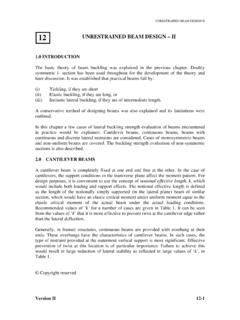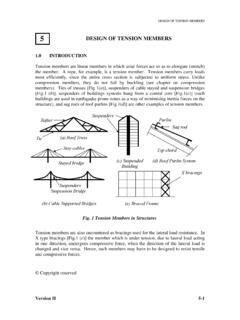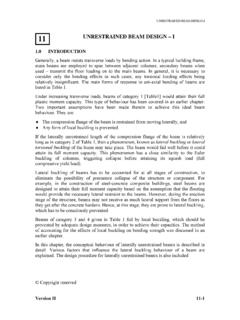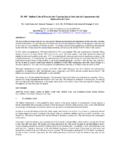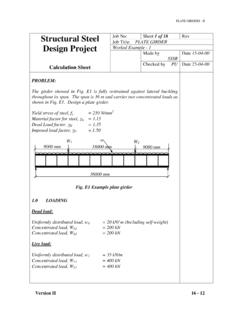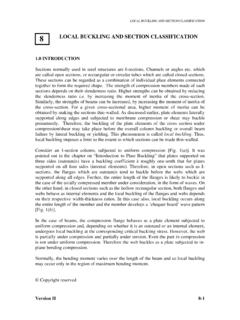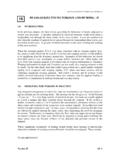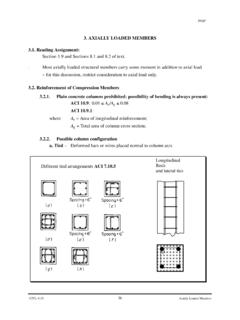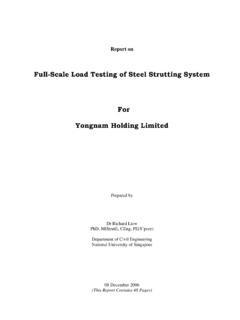Transcription of COLD FORMED STEEL SECTIONS- II
1 cold FORMED STEEL SECTIONS- II cold FORMED STEEL SECTIONS- II 20 INTRODUCTION In the last chapter, the special features and attractions of cold FORMED STEEL sections for many industrial applications were presented and discussed. In view of the use of very thin STEEL sheet sections, (generally in the 1 mm - 3 mm range), particular attention has to be paid to buckling of these elements. Stiffened and unstiffened elements were compared and the concept of effective width to deal with the rapid design of compression elements together with suitable design simplifications, outlined. Finally, the methods adopted for the design of laterally restrained beams and unrestrained beams were discussed. The techniques of eliminating lateral buckling in practice, by providing lateral braces or by attachment to floors etc were described so that the compression flanges would not buckle laterally.
2 In this chapter the design of columns for axial compression, compression combined with bending as well as for torsional-flexural buckling will be discussed. The diversity of cold FORMED STEEL shapes and the multiplicity of purposes to which they are put to, makes it a difficult task to provide general solution procedures covering all potential uses. Some design aspects are nevertheless included to provide a general appreciation of this versatile product. It is not unusual to design some cold FORMED STEEL sections on the basis of prototype tests or by employing empirical rules. These are also discussed in a summary form herein. AXIALLY COMPRESSED columns As pointed out in the last chapter, local buckling under compressive loading is an extremely important feature of thin walled sections. It has been shown that a compressed plate element with an edge free to deflect does not perform as satisfactorily when compared with a similar element supported along the two opposite edges.
3 Methods of evaluating the effective widths for both edge support conditions were presented and discussed. In analysing column behaviour, the first step is to determine the effective area (Aeff) of the cross section by summing up the total values of effective areas for all the individual elements. The ultimate load (or squash load) of a short strut is obtained from Pcs = Aeff . fyd = Q. A. fyd (1) Copyright reserved Version II 20-1 cold FORMED STEEL SECTIONS- II where Pcs = ultimate load of a short strut Aeff = sum of the effective areas of all the individual plate elements Q = the ratio of the effective area to the total area of cross section at yield stress In a long column with doubly - symmetric cross section , the failure load (Pc) is dependent on Euler buckling resistance (PEY) and the imperfections present.
4 The method of analysis presented here follows the Perry-Robertson approach presented in the chapter on "Introduction to Column Buckling". Following that approach, the failure load is evaluated from ()[]()[]{})2(,)2(,)2( => = ++ ++= 22eminEI PEY = the minimum buckling load of column = and ry = radius of gyration corresponding to PEY. Q = 0 .3Q = 1 Q = 0 .4 Q = 0 .5 Q = 0 .6 Q = 0 .7 Q = 0 .8Q = 0 .9 pc / fy 20 40 80 120 160 200 e / ry Fig. 1 Column Strength (non- dimensional) for different Q factors Version II 20-2 cold FORMED STEEL SECTIONS- II Fig. 1 shows the mean stress at failure (pc = Pc / cross sectional area) obtained for columns with variation of e /ry for a number of "Q" factors. (The y-axis is non dimensionalised using the yield stress, fy and "Q" factor is the ratio of effective cross sectional area to full cross sectional area).
5 Plots such as Fig. 1 can be employed directly for doubly symmetric sections. Neutral axis ABLoad point B ALoad point Effective section neutral axises (b) The move of the neutral axis (due to plate buckling) causes an eccentricity es and a consequent moment P. es . This would cause an additional compression on flange AB (a) Channel section loaded through its centroid Fig. 2 Effective shift in the loading axis in an axially compressed column Effective shift of loading axis If a section is not doubly symmetric (see Fig. 2) and has a large reduction of effective widths of elements, then the effective section may be changed position of centroid. This would induce bending on an initially concentrically loaded section , as shown in Fig. 2. To allow for this behaviour, the movement of effective neutral axis (es) from the geometric neutral axis of the cross section must be first determined by comparing the gross and effective section properties.
6 The ultimate load is evaluated by allowing for the interaction of bending and compression using the following equation: )3(.sccccultePMMPP+ = where Pc is obtained from equation (2) and Mc is the bending resistance of the section for moments acting in the direction corresponding to the movement of neutral axis; es is the distance between the effective centroid and actual centroid of the cross section . Torsional - flexural buckling Singly symmetric columns may fail either (a) by Euler buckling about an axis perpendicular to the line of symmetry (as detailed in above) or (b) by a combination of bending about the axis of symmetry and a twist as shown in Fig. 3. This latter type of Version II 20-3 cold FORMED STEEL SECTIONS- II behaviour is known as Torsional-flexural behaviour. Purely torsional and purely flexural failure does not occur in a general case. v Shear centreOriginal position Position after Flexural - Torsional buckling Axis of symmetry Fig.
7 3 Column displacements during Flexural - Torsional buckling Theoretical methods for the analysis of this problem was described in the chapters on Beam columns . Analysis of torsional-flexural behaviour of cold FORMED sections is tedious and time consuming for practical design. Codes deal with this problem by simplified design methods or by empirical methods based on experimental data. As an illustration, the following design procedure, suggested in BS5950, Part 5 is detailed below as being suitable for sections with at least one axis of symmetry (say x - axis) and subjected to flexural torsional buckling. Effective length multiplication factors (known as factors) are tabulated for a number of section geometries. These factors are employed to obtain increased effective lengths, which together with the design analysis prescribed in above can be used to obtain torsional buckling resistance of a column.
8 4(,1,TFEYTFEYTFEYPPPPForPPFor=>= values can be computed as follows: where PEY is the elastic flexural buckling load (in Newtons) for a column about the y- Version II 20-4 cold FORMED STEEL SECTIONS- II axis, 22eyEI e = effective length ( in mm) corresponding to the minimum radius of gyration PTF = torsional flexural buckling load (in Newtons) of a column given by ()(){})5(421212 + +=TEXTEXTEXTFPPPPPPP where PEX = Elastic flexural buckling load of the column (in Newtons ) about the x- axis given by 22exEI PT = Torsional buckling load of a column ( In Newtons) given by (6) 2rP +=22021eT EGJ )7( is a constant given by (7) 2001 =r x In these equations, ro = polar radius of gyration about the shear centre (in mm) given by ())
9 8(2120220xrrryx++= where rx, ry are the radii of gyration (in mm) about the x and y- axis G is the shear modulus (N/mm2) x0 is the distance from shear centre to the centroid measured along the x axis (mm) J St Venants' Torsion constant (mm4) which may be taken as , summed up for b33t all elements, where b = flat width of the element and t= thickness (both of them measure in mm) Ix the moment of inertia about the x axis (mm4) Warping constant for all section . Version II 20-5 cold FORMED STEEL SECTIONS- II Torsion Behaviour cold FORMED sections are mainly FORMED with "open" sections and do not have high resistance to torsion. Hence the application of load which would cause torsion should be avoided where possible. Generally speaking, by adjusting the method of load application, it is possible to restrain twisting so that torsion does not occur to any significant extent.)
10 In general, when examining torsional behaviour of thin walled sections, the total torsion may be regarded as being made up of two effects: St. Venant's Torsion or Pure Torsion Warping torsion. 's torsion produces shear stresses, which vary linearly through the material thickness. Warping torsion produces in-plane bending of the elements of a cross section , thus inducing direct ( normal) stresses and the angle of twist increases linearly. Since cold FORMED sections are thin walled, they have very little resistance to St. Venant's Torsion and will twist substantially. The extent of warping torsion in a thin walled beam is very much dependent on the warping restraint afforded by the supports as well as the loading conditions and the type of section . If the beam ends are restrained from warping, then short beams exhibit high resistance to warping torsion and the total torque acting on such a beam will be almost completely devoted to overcoming warping resistance, the St Venant's Torsion being negligible.
